Dosing & Uses
Dosage Forms & Strengths
powder for injection
- 500mg/vial
- 2g/vial
Acute Iron Poisoning
IM administration is indicated for all patients NOT in shock; administer 1g IM initially and then 500mg Q4hr for 2 doses
Depending upon clinical response, subsequent doses of 500mg Q4-12hr can be administered
Maximum dose: 6g in 24 hours
IV administration should be reserved for patients in a state of cardiovascular collapse or shock; 1g slow IV infusion
Rate of infusion should not exceed 15mg/kg/hr for the first dose; subsequent doses should not be infused at a faster rate than 125mg/hr
Chronic Iron Overload
SC administration: 1-2g (20-40mg/kg/day) SC over 8-24 hours using a small portable pump capable of providing continuous mini-infusion; individualize infusion duration
IV administration in patients with IV access: 40-50mg/kg/day over 8-12 hours for 5-7 days/ week (maximum of < 60mg/kg/day and an IV infusion rate of <15mg/kg/hr)
IM administration: 0.5-1g QD (maximum of 1g QD)
Sickle Cell Leg Ulcers (Orphan)
Orphan designation for treatment of sickle cell leg ulcers
Orphan spnsor
- TauTona Group; 604 Fifth Avenue; Redwood City, California 94063
Additional Information
Can be administered prior to or following same day blood transfusion in patients that are poorly compliant; should not be administered concurrently as this can lead to errors in interpretation of ADRs
Dosage Forms & Strengths
powder for injection
- 500mg/vial
- 2g/vial
Acute Iron Poisoning
<3 years: Safety and effectiveness has not been established
≥3 years: Administer 1g IM initially and then 500mg Q4hr for 2 doses for all patients not in shock
Depending upon clinical response, subsequent doses of 500mg Q4-12hr can be administered; maximum dose: 6g in 24 hours
IV administration should be reserved for patients in a state of cardiovascular collapse or shock; 1g slow IV infusion
Rate of infusion should not exceed 15mg/kg/hr for the first dose; subsequent doses should not be infused at a faster rate than 125mg/hr
20 mg/kg IM (for all patients not in shock) or IV (only if patient in cardiovascular collapse/shock); then, 10 mg/kg IM/IV q4hr x2; then, depending on clinical circumstance, may administer addtional doses of 10 mg/kg IM/IV q4-12hr PRN
IV infusion rate: Initial 1 g at 15 mg/kg/hr, all subsequent doses no more than 125 mg/hr
No more than 6 g/day (IM/IV), but in severe cases should continue infusion up to 24 hours
Chronic Iron Overload
<3 years: Safety and effectiveness has not been established
≥3 years: 0.5-1g IM QD (maximum of 1g QD)
SC administration: 1-2g (20-40mg/kg/day) SC over 8-24 hours using a small portable pump capable of providing continuous mini-infusion; individualize infusion duration
IV administration in patients with IV access: 40-50mg/kg/day over 8-12 hours for 5-7 days/ week (maximum of < 60mg/kg/day and an IV infusion rate of <15mg/kg/hr)
Additional Information
Can be administered prior to or following same day blood transfusion in patients that are poorly compliant; should not be administered concurrently as this can lead to errors in interpretation of ADRs
Interactions
Interaction Checker
No Results

Contraindicated
Serious
Significant - Monitor Closely
Minor

Contraindicated (0)
Serious (3)
- betibeglogene autotemcel
betibeglogene autotemcel increases effects of deferoxamine by immunosuppressive effects; risk of infection. Avoid or Use Alternate Drug. Discontinue iron chelators at least 7 days before starting conditioning. Some iron chelators are myelosuppressive. After infusion, avoid use of these iron chelators for 6 months. If iron chelation is needed, consider administration of nonmyelosuppressive iron chelators. Phlebotomy can be used in lieu of iron chelation, when appropriate.
- exagamglogene autotemcel
deferoxamine, exagamglogene autotemcel. Other (see comment). Avoid or Use Alternate Drug. Comment: Discontinue iron chelators at least 7 days before mobilization and conditioning. .
- lovotibeglogene autotemcel
deferoxamine, lovotibeglogene autotemcel. Other (see comment). Avoid or Use Alternate Drug. Comment: Discontinue iron chelators at least 7 days before mobilization and conditioning.
Monitor Closely (16)
- aluminum hydroxide
deferoxamine decreases levels of aluminum hydroxide by inhibition of GI absorption. Applies only to oral form of both agents. Use Caution/Monitor. Deferoxamine chelates iron; its affinity for other minerals is unknown.
- ascorbic acid
deferoxamine, ascorbic acid. Other (see comment). Use Caution/Monitor. Comment: Ascorbic acid increases the availability of iron for chelation with deferoxamine. Ascorbic acid should be avoided in pts. with cardiac failure undergoing deferoxamine Tx. Clinical cardiac monitoring recommended for pts. supplemented with ascorbic acid.
- calcium carbonate
deferoxamine decreases levels of calcium carbonate by inhibition of GI absorption. Applies only to oral form of both agents. Use Caution/Monitor. Deferoxamine chelates iron; its affinity for other minerals is unknown.
- carbonyl iron
deferoxamine decreases levels of carbonyl iron by inhibition of GI absorption. Applies only to oral form of both agents. Use Caution/Monitor. Deferoxamine chelates iron.
- ferric maltol
deferoxamine decreases levels of ferric maltol by inhibition of GI absorption. Applies only to oral form of both agents. Use Caution/Monitor. Deferoxamine chelates iron.
- ferrous fumarate
deferoxamine decreases levels of ferrous fumarate by inhibition of GI absorption. Applies only to oral form of both agents. Use Caution/Monitor. Deferoxamine chelates iron.
- ferrous gluconate
deferoxamine decreases levels of ferrous gluconate by inhibition of GI absorption. Applies only to oral form of both agents. Use Caution/Monitor. Deferoxamine chelates iron.
- ferrous sulfate
deferoxamine decreases levels of ferrous sulfate by inhibition of GI absorption. Applies only to oral form of both agents. Use Caution/Monitor. Deferoxamine chelates iron.
- iron dextran complex
deferoxamine decreases levels of iron dextran complex by inhibition of GI absorption. Applies only to oral form of both agents. Use Caution/Monitor. Deferoxamine chelates iron.
- iron sucrose
deferoxamine decreases levels of iron sucrose by inhibition of GI absorption. Applies only to oral form of both agents. Use Caution/Monitor. Deferoxamine chelates iron.
- polysaccharide iron
deferoxamine decreases levels of polysaccharide iron by inhibition of GI absorption. Applies only to oral form of both agents. Use Caution/Monitor. Deferoxamine chelates iron.
- prochlorperazine
deferoxamine, prochlorperazine. Either increases toxicity of the other by Mechanism: pharmacodynamic synergism. Use Caution/Monitor. Synergistic increase in neurological adverse effects.
- rose hips
deferoxamine, rose hips. Other (see comment). Use Caution/Monitor. Comment: Ascorbic acid increases the availability of iron for chelation with deferoxamine. Ascorbic acid should be avoided in pts. with cardiac failure undergoing deferoxamine Tx. Clinical cardiac monitoring recommended for pts. supplemented with ascorbic acid.
deferoxamine decreases levels of rose hips by inhibition of GI absorption. Applies only to oral form of both agents. Use Caution/Monitor. Deferoxamine chelates iron. - sodium bicarbonate
deferoxamine decreases levels of sodium bicarbonate by inhibition of GI absorption. Applies only to oral form of both agents. Use Caution/Monitor. Deferoxamine chelates iron; its affinity for other minerals is unknown.
- sodium citrate/citric acid
deferoxamine decreases levels of sodium citrate/citric acid by inhibition of GI absorption. Applies only to oral form of both agents. Use Caution/Monitor. Deferoxamine chelates iron; its affinity for other minerals is unknown.
- tobramycin inhaled
tobramycin inhaled and deferoxamine both increase nephrotoxicity and/or ototoxicity. Modify Therapy/Monitor Closely. Avoid concurrent or sequential use to decrease risk for ototoxicity
Minor (0)
Adverse Effects
Frequency Not Defined
Injection site reactions (eg, localized irritation, induration, infiltration, pain, erythema, wheal formation, eschar, burning, swelling, pruritus, crust, vesicles, local edema); these may be associated with systemic allergic reactions
Systemic reactions (eg, abdominal pain, arthralgia, asthma, fever, headache, myalgia, nausea, vomiting)
Cardiovascular reactions (eg, hypotension with too rapid IV infusion, tachycardia, shock)
Hypersensitivity reactions (eg, anaphylactic reaction with or without shock, angioedema, generalized rash, urticaria)
Digestive reactions (eg, abdominal discomfort, diarrhea, nausea, vomiting)
Hematologic reactions (eg, blood dyscrasia including thrombocytopenia and leucopenia)
Hepatic reactions (eg, increased transaminases, hepatic dysfunction)
Musculoskeletal reactions (eg, muscle spasms, growth retardation and bone changes including metaphyseal dysplasia are common in doses ≥ 60 mg/kg, especially those who begin iron chelation in the first three years of life; reduced risk if doses are kept to ≤ 40 mg/kg)
Nervous System reactions (eg, neurological disturbances including dizziness, peripheral sensory, motor, or mixed neuropathy, paresthesias, seizures; exacerbation or precipitation of aluminum-related dialysis encephalopathy)
Special Senses reactions (eg, high-frequency sensorineural hearing loss and/or tinnitus are uncommon if dosage guidelines are not exceeded and if dose is reduced when ferritin levels decline; visual disturbances inlcuding decreased acuity, blurred vision, loss of vision, dyschromatopsia, night blindness, visual field defects, scotoma, retinopathy (pigmentary degeneration), optic neuritis, and cataracts are rare if dosage guidelines are not exceeded)
Respiratory reactions (eg, acute respiratory distress syndrome with dyspnea, cyanosis, and/or interstitial infiltrates)
Very rare generalized rash
Urogenital reactions including dysuria, acute renal failure, increased serum creatinine and renal tubular disorders
Postmarketing Reports
Renal dysfunction, including renal failure; monitor patients for changes in renal function (eg, increased serum creatinine)
Warnings
Contraindications
Known hypersensitivity to deferoxamine or any of its components
Patients with severe renal disease or anuria
Cautions
Flushing of the skin, urticaria, hypotension, and shock have occurred when drug administered by rapid intravenous injection; best to administer IM slow SC or IV infusion
Rare cases of mucormycosis, some with a fatal outcome, reported with use; if any of suspected signs or symptoms occur, discontinue treatment; mycological tests should be carried out and appropriate treatment instituted immediately
Adult respiratory distress syndrome, also reported in children described following treatment with excessively high intravenous doses in patients with acute iron intoxication or thalassemia
Increases in serum creatinine (possibly dose-related), acute renal failure, and renal tubular disorders, reported in postmarketing experience; monitor patients for changes in renal function
Severe chronic iron overload may precipitate reversible cardiac function impairment if high doses of Vitamin C (>500 mg/day in adults) are given concomitantly; do not administer Vitamin C to HF patients; wait >1 month after treatment to begin supplemental vitamin C therapy; administer vitamin C only if the patient is receiving deferoxamine regularly, ideally soon after setting up the infusion pump; do not exceed a daily vitamin C dose of 200 mg in adults, given in divided doses; monitor cardiac function closely during such combined therapy
Dialysis patients with aluminum-related encephalopathy may experience neurological dysfunction (seizures), possibly due to an acute increase in circulating aluminum;onset of dialysis dementia may be precipitated; treatment in the presence of aluminum overload may result in decreased serum calcium and aggravation of hyperparathyroidism
Not a substitute for standard measures generally used in iron toxicity (eg, induced emesis, gastric lavage)
Iron overload increases susceptibility of patients to Yersinia enterocolitica and Yersinia pseudotuberculosis infections; treatment may therefpre enhance patient's susceptibility; if it occurs, treatment should be discontinued until infection is resolved
Monitor pediatric patients for body weight and growth every 3 months; high doses and concomitant low ferritin levels associated with growth retardation; after reduction of dose, growth velocity may partially resume to pretreatment rates
Ocular and auditory disturbances
- Ocular and auditory disturbances reported when therapy administered over prolonged periods of time, at high doses, or in patients with low ferritin levels; in most cases, both ocular and auditory disturbances were reversible upon immediate cessation of treatment
- Visual acuity tests, slit-lamp examinations, funduscopy and audiometry recommended periodically in patients treated for prolonged periods of time; toxicity is more likely to be reversed if symptoms or test abnormalities are detected early
-
Ocular disturbances observed include
- Blurring of vision; cataracts after prolonged administration in chronic iron overload
- Decreased visual acuity including visual loss, visual defects, scotoma
- Impaired peripheral, color, and night vision; optic neuritis, cataracts, corneal opacities, and retinal pigmentary abnormalities
-
Auditory abnormalities reported include
- Tinnitus and hearing loss including high-frequency sensorineural hearing loss
-
Pregnancy & Lactation
Pregnancy
There are no adequate and well-controlled studies in pregnant women; administer during pregnancy only if potential benefit justifies potential risk to fetus
Animal data
- Delayed ossification in mice and skeletal anomalies in rabbits observed after drug administered in daily doses up to 4.5 times the maximum daily human dose; no adverse effects observed in similar studies in rats
Lactation
Not known whether drug is excreted in human milk; because many drugs are excreted in human milk, caution should be exercised when administered to a nursing woman
Pregnancy Categories
A: Generally acceptable. Controlled studies in pregnant women show no evidence of fetal risk.
B: May be acceptable. Either animal studies show no risk but human studies not available or animal studies showed minor risks and human studies done and showed no risk. C: Use with caution if benefits outweigh risks. Animal studies show risk and human studies not available or neither animal nor human studies done. D: Use in LIFE-THREATENING emergencies when no safer drug available. Positive evidence of human fetal risk. X: Do not use in pregnancy. Risks involved outweigh potential benefits. Safer alternatives exist. NA: Information not available.Pharmacology
Mechanism of Action
Desferal chelates iron by forming a stable complex that prevents the iron from entering into further chemical reactions; also chelates iron readily from ferritin and hemosiderin but not readily from transferrin; does not combine with the iron from cytochromes and hemoglobin; chelate is readily soluble and is renally excreted
Pharmacokinetics
Metabolism: Principally by plasma enzymes; pathways not yet defined
Excretion: Primarily urine; partly excreted in feces
Additional Information
100mg of deferoxamine binds to about 10mg of iron and 4.1mg of aluminum
End points of treatment are clinical improvement, resolution of anion gap and acidosis, return of urine color to baseline, serum iron level ≤ 100 mcg/dL
Vin Rose urine, or a change in urine color from baseline, indicates presence of deferoxamine-iron chelate; may not always be present, so cannot be used to rule out significant iron ingestion; patient should be advised to obtain baseline urine for visual comparison and keep at bedside
Administration
Reconstitution
Preparation for IM administration: 500mg with 2mL SWI/ 2g with 8mL SWI (final concentration after reconstitution for both: 213mg/mL)
Preparation for IV administration: 500mg with 5mL SWI/ 2g with 20mL SWI (final concentration after reconstitution for both: 95mg/mL)
Preparation for SC administration: 500mg with 5mL SWI/ 2g with 20mL SWI (final concentration after reconstitution for both: 95mg/mL)
Use immediately; ≤ 3hours of reconstitution
When reconstitution is carried under aseptic conditions, may store ≤ 24 hr at 25°C; do not refrigerate; do not reconstitute with other solvents or under different conditions due to risk of precipitation
Images
| BRAND | FORM. | UNIT PRICE | PILL IMAGE |
|---|---|---|---|
| deferoxamine injection - | 500 mg vial | 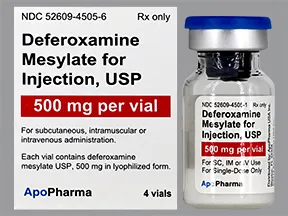 | |
| deferoxamine injection - | 2 gram vial | 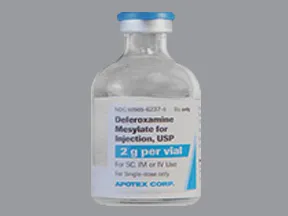 | |
| deferoxamine injection - | 500 mg vial |  | |
| deferoxamine injection - | 500 mg vial | 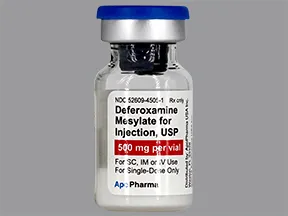 | |
| deferoxamine injection - | 2 gram vial |  | |
| deferoxamine injection - | 2 gram vial | 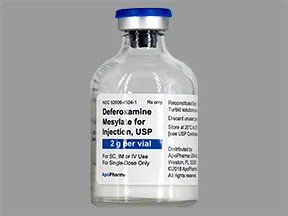 | |
| deferoxamine injection - | 2 gram vial | 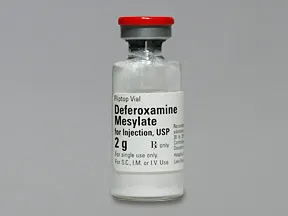 | |
| deferoxamine injection - | 2 gram vial |  | |
| deferoxamine injection - | 500 mg vial | 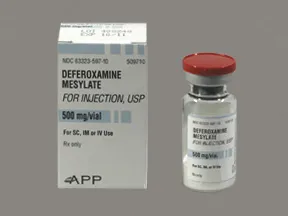 | |
| Desferal injection - | 500 mg vial |  |
Copyright © 2010 First DataBank, Inc.
Patient Handout
deferoxamine injection
DEFEROXAMINE - INJECTION
(deff-er-OX-uh-meen)
COMMON BRAND NAME(S): Desferal
USES: This medication is used along with other treatments (such as causing vomiting with syrup of ipecac, stomach pumping) to treat sudden iron poisoning. It is most effective when given as soon as possible after the iron was eaten. This medication can also be used to help get rid of iron in patients with high iron levels due to many blood transfusions. Deferoxamine is an iron-binding agent that belongs to a class of drugs known as heavy metal antagonists. It works by helping the kidneys and gallbladder get rid of the extra iron.This medication is not recommended for use in children less than 3 years old (see also Precautions section).
HOW TO USE: Depending upon your medical condition, this medication is injected directly into a muscle, under the skin, or into a vein as directed by your doctor.Dosage is based on your medical condition and response to treatment.If you are giving this medication to yourself at home, learn all preparation and usage instructions from your health care professional. Before using, check this product visually for particles or discoloration. If either is present, do not use the liquid. Learn how to store and discard medical supplies safely.If you are using this medication to treat high iron levels, your doctor may direct you to take vitamin C (ascorbic acid) after you have been using this medication for at least 1 month. Taking vitamin C will help replace the loss of vitamin C due to high iron levels and help the medication work to get rid of the iron. If you have heart disease (such as heart failure), tell your doctor before taking vitamin C while using this medication (see also Drug Interactions). The manufacturer recommends that adults using this drug take no more than 200 milligrams of vitamin C a day.Tell your doctor if your condition lasts or gets worse.
SIDE EFFECTS: Pain and swelling at the injection site or blurred vision may occur. If any of these effects last or get worse, tell your doctor or pharmacist promptly.This medicine may cause your urine to turn reddish. This effect is harmless.When this medication is given into a vein, flushing, severe itching, severe dizziness, fast heartbeat, and fainting can occur. The manufacturer recommends that, when possible, this medication be given either in the muscle or under the skin.Remember that this medication has been prescribed because your doctor has judged that the benefit to you is greater than the risk of side effects. Many people using this medication do not have serious side effects.Tell your doctor right away if you have any serious side effects, including: other vision changes (such as vision loss, loss of color vision, cataracts), eye pain, hearing changes (such as ringing ears, decreased hearing/loss).Rarely, this drug may cause serious (sometimes fatal) bacterial or fungal infections. Get medical help right away if you notice any of the following: unexplained diarrhea/abdominal pain/fever.This drug may rarely cause a serious (rarely fatal) lung condition (acute respiratory distress syndrome or ARDS). Get medical help right away if you notice any of the following: sudden/severe shortness of breath, labored or rapid breathing, severe dizziness.A very serious allergic reaction to this drug is rare. However, get medical help right away if you notice any symptoms of a serious allergic reaction, including: rash, itching/swelling (especially of the face/tongue/throat), severe dizziness, trouble breathing.This is not a complete list of possible side effects. If you notice other effects not listed above, contact your doctor or pharmacist.In the US -Call your doctor for medical advice about side effects. You may report side effects to FDA at 1-800-FDA-1088 or at www.fda.gov/medwatch.In Canada - Call your doctor for medical advice about side effects. You may report side effects to Health Canada at 1-866-234-2345.
PRECAUTIONS: Before using deferoxamine, tell your doctor or pharmacist if you are allergic to it; or if you have any other allergies. This product may contain inactive ingredients, which can cause allergic reactions or other problems. Talk to your pharmacist for more details.Before using this medication, tell your doctor or pharmacist your medical history, especially of: kidney problems, rheumatoid arthritis, diabetes, any fungal infection.If you are using this medication for aluminum poisoning, also tell your doctor or pharmacist if you have: seizures, decreased calcium levels in the blood, hyperparathyroidism.This drug may make you dizzy or blur your vision. Alcohol or marijuana (cannabis) can make you more dizzy. Do not drive, use machinery, or do anything that needs alertness or clear vision until you can do it safely. Limit alcoholic beverages. Talk to your doctor if you are using marijuana (cannabis).Children (especially those younger than 3 years of age) may be more sensitive to the side effects of this drug, especially the effects on bone growth.Older adults may be more sensitive to the side effects of this drug, especially vision/hearing problems.During pregnancy, this medication should be used only when clearly needed. It may harm an unborn baby. Ask about reliable forms of birth control while using this medication and for 1 month after the last dose. Discuss the risks and benefits with your doctor.It is unknown if this medication passes into breast milk. Because of the possible risk to the infant, breastfeeding is not recommended while using this medication and for 1 week after the last dose. Consult your doctor before breastfeeding.
DRUG INTERACTIONS: Drug interactions may change how your medications work or increase your risk for serious side effects. This document does not contain all possible drug interactions. Keep a list of all the products you use (including prescription/nonprescription drugs and herbal products) and share it with your doctor and pharmacist. Do not start, stop, or change the dosage of any medicines without your doctor's approval.A product that may interact with this drug is: prochlorperazine.If you have a certain heart problem (heart failure), this drug should not be used with vitamin C (ascorbic acid) because very serious interactions may occur. Consult your doctor or pharmacist for more details before starting deferoxamine.This medication may interfere with certain lab tests (such as gallium scintigraphy), possibly causing false test results. Make sure lab personnel and all your doctors know you use this drug.
OVERDOSE: If someone has overdosed and has serious symptoms such as passing out or trouble breathing, call 911. Otherwise, call a poison control center right away. US residents can call 1-800-222-1222. Canada residents can call 1-844-764-7669. Symptoms of overdose may include: severe dizziness, fainting, fast heartbeat, loss of vision, sudden paleness in face/lips/palms of hands, coma.
NOTES: Do not share this medication with others.In patients receiving this medication long-term, lab and/or medical tests (such as eye exams, hearing tests, growth and body weight in children, kidney function tests, cardiac function tests in patients using deferoxamine and vitamin C) should be done while you are using this medication. Keep all medical and lab appointments. Consult your doctor for more details.
MISSED DOSE: It is important to get each dose of this medication as scheduled. If you miss a dose, ask your doctor or pharmacist right away for a new dosing schedule. Do not double the dose to catch up.
STORAGE: Store unmixed vials at room temperature away from light and moisture. Do not store in the bathroom. After mixing, use within time period indicated in product instructions. Discard unused portion. Keep all medications away from children and pets.Do not flush medications down the toilet or pour them into a drain unless instructed to do so. Properly discard this product when it is expired or no longer needed. Consult your pharmacist or local waste disposal company.
Information last revised May 2024. Copyright(c) 2024 First Databank, Inc.
IMPORTANT: HOW TO USE THIS INFORMATION: This is a summary and does NOT have all possible information about this product. This information does not assure that this product is safe, effective, or appropriate for you. This information is not individual medical advice and does not substitute for the advice of your health care professional. Always ask your health care professional for complete information about this product and your specific health needs.
Formulary
Adding plans allows you to compare formulary status to other drugs in the same class.
To view formulary information first create a list of plans. Your list will be saved and can be edited at any time.
Adding plans allows you to:
- View the formulary and any restrictions for each plan.
- Manage and view all your plans together – even plans in different states.
- Compare formulary status to other drugs in the same class.
- Access your plan list on any device – mobile or desktop.


